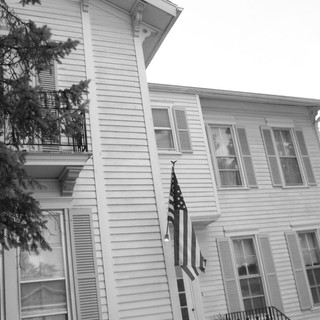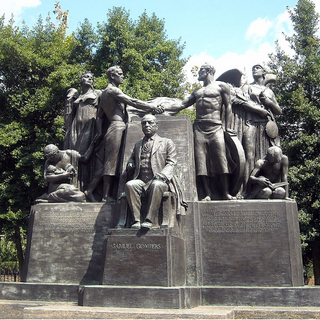Woman with Hannibal ties played a pivotal role in D.C.
- Mary Lou Montgomery

- Sep 2, 2016
- 4 min read

At right: Florence Calvert Thorne, Leavenworth (Kansas) Times, Sept. 22, 1919. Newspapers.com
MARY LOU MONTGOMERY
In 1918, Florence Calvert Thorne was assigned to inspect work conditions in the war industries in connection with her role with the U.S. Department of Labor. She was charged with determining the standards that should be maintained, and adopting rules and means for enforcing these standards.
She was appointed to this post by W.B. Wilson, U.S. Secretary of Labor.
With the country in the final months of what was coined by President Woodrow Wilson as “the war to end war,” Thorne’s state-side appointment was particularly noteworthy. With men at war, women were increasingly tapped to fill essential roles on U.S. soil.
Thorne was vastly qualified for this post, after serving six years as assistant editor of the American Federationist, the official magazine of the AFL – American Federation of Labor. She was a 1909 graduate of the University of Chicago, where she studied philosophy, and studied for two years at Oberlin College, Ohio, before moving to Washington.
Hannibal connections
Florence Calvert Thorne was born in 1877 at Hannibal, Mo., the youngest daughter of Stephen, a Hannibal educator and later a Main Street grocer, and Amanthis Belle Mathews Thorne. Florence’s grandfather, George W. Mathews, had been the first white child born north of North River in Marion County, Mo. And following her mother’s ancestral line, Florence was a lineal descendant of George Calvert and his son, Cecil Calvert, the first and second Lord Baltimores.
History reminds us that George and his son Cecil were the founders of the Maryland colony.
Amanthis went by her middle name, Belle, and during most of their years in Hannibal – until 1913 – she and her family made their home in the still-impressive dwelling located at 523 North Fifth Street.
Ashlie and her husband, Ryan Gilmore, recently purchased the house that the Thornes’ called home for so many years, and are enjoying the discovery of the dwelling’s heritage.
The house
Florence Thorne was little more than a toddler when the family moved into this house overlooking the Mississippi River. After figuratively cutting her teeth of the home’s banister, she attended Hannibal public schools, and ultimately graduated from the University of Chicago. In 1910, she was a teacher at Hannibal High School, and soon thereafter, she left Hannibal in order to do graduate work at Oberlin College in Ohio.
A story published upon her death in the Evening Star, Washington, D.C., on March 17, 1973, reported that while doing graduate work at the university, Miss Thorne sought information for a thesis on the AFL from Samuel Gompers who was then AFL president.
“Gompers opened the AFL’s files to Miss Thorne for her research work and subsequently offered her a job on the ‘American Federationist,’ official magazine of the federation. Soon thereafter she became Gompers’ assistant, doing research on legislative, political and economic problems of concern to the AFL.
“Prior to World War I, Miss Thorne’s research included work on such issues as child labor, the eight hour day, and the Clayton Anti-trust Act.”
After World War I she returned to the AFL.
“After Gompers’ death in 1924, his previously expressed desire for a staff of researchers slowly became a reality. In 1926, his successor, William Green, authorized use of volunteer workers under Miss Thorne’s direction. The researchers developed a system of unemployment reporting by local unions which became particularly useful during the depression of the 1930s.”
By 1933, the research staff headed by Miss Thorne was a paid staff. Miss Thorne was named director of research, and she held that post until her retirement in 1953.
“Her work contributed to the development of the Social Security and unemployment compensation systems, health and medical care plans for workers and was instrumental in setting up periodic conferences between the federation’s research staff and government research agencies,” the Evening Star reported.
After her retirement, she wrote a biography of Samuel Gompers, “American Statesman,” which was published in 1957.
Gompers Square
On Oct. 27, 1951, President Harry S Truman spoke at a dedication ceremony for a triangular plot near the AFL headquarters in Washington, D.C. The spot was to be known as “Gompers Square.” Upon the plot of land stands a statue of Mr. Gompers, surrounded by workers. The ceremony took place on the 101st anniversary of Gompers’ birth.
The president’s daughter, Margaret Truman, was in the audience. Upon the platform sat two of Gomper’s former aides, John Frey, who had retired from his post, and Florence Thorne.
Family
Florence Thorne’s father moved back to his home state of Georgia after leaving Hannibal in 1913. He died March 16, 1920, in Savannah, Ga.
That same year, Florence Thorne’s mother, Belle, moved to Washington, D.C., to make her home with her daughter. Belle died in October 1932. Florence’s older sister, Mary V. Thorne, who had worked as a clerk in her father’s grocery store in Hannibal and who later became a commercial artist, died May 31, 1952.
Florence lived to be 95 years old, dying in March 1973.
Virginia property
An interesting sidelight to Florence Thorne’s life centers around the home she shared with Margaret Scattergood during their retirement years. The CIA Campus Chronicles reported that in 1933, Margaret Scattergood and Florence Thorne purchased a 20-acre tract of land that was previously a part of the historic Rokeby Farm in Virginia.
In 1935, they acquired an adjoining 12 acres. The two women named their turn-of-the-century, wood-framed residence Calvert House, and the property became known as the Calvert Estate.
In the 1850s, the CIA obtained 225 acres of property – including the Calvert estate - to house its new headquarters. The land acquisition came with a caveat, however. Scattergood and Thorne would be allowed to live on the property until their respective deaths. Thorne died in 1973, as previously mentioned. Scattergood died in 1986, and the CIA assumed possession of the property the following year.
The agency converted the house into a conference center and it is still in use.




























Comments